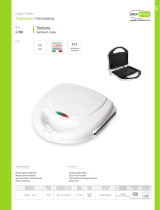Page
CONTENTS
1. PRODUCT NAME ............................................................................................................................ 1
2. MARKETING OBJECTIVE .............................................................................................................. 1
3. APPLICATIONS .............................................................................................................................. 1
4. SELLING POINTS ........................................................................................................................... 1
4-1. Selling Point Descriptions ................................................................................................................ 2
5. SPECIFICATIONS ........................................................................................................................... 3
6. SPECIFICATION COMPARISONS WITH SIMILAR PRODUCTS................................................... 4
7. PRECAUTIONS IN SALES PROMOTION ...................................................................................... 5
7-1. Handling Instructions ........................................................................................................................5
7-2. Precautions on Caution Plate ...........................................................................................................5
8. DUST COLLECTION ....................................................................................................................... 6
8-1. Dust Collector ...................................................................................................................................6
8-2. To Maintain Dust Collecting Performance .........................................................................................6
8-3. Others ...............................................................................................................................................6
9. PRECAUTIONS IN DISASSEMBLY AND REASSEMBLY ............................................................. 7
9-1. Disassembly .....................................................................................................................................7
9-2. Reassembly .................................................................................................................................... 11
9-3. Wiring Procedures ..........................................................................................................................12
9-4. Wiring Diagram ...............................................................................................................................13
9-5. Tightening Torque ...........................................................................................................................14
9-6. Insulation Test .................................................................................................................................14
9-7. No-load Current Value ....................................................................................................................14
10. STANDARD REPAIR TIME (UNIT) SCHEDULES ...................................................................... 15
Assembly Diagram for SB 10S2
Assembly Diagram for SB 10V2





















